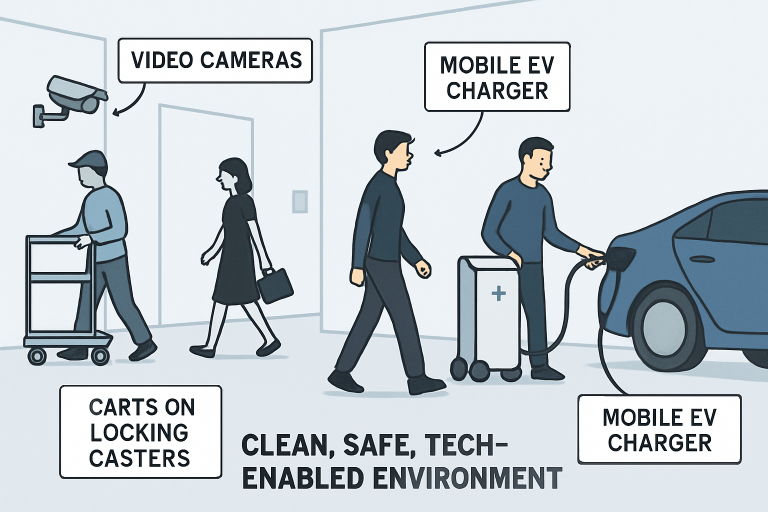In modern facility management, ensuring the safe and efficient movement of people, equipment, and vehicles is vital. With the rapid advancement of technology, many organizations are now embracing innovative mobility solutions to elevate their operational standards. Essential components, such as locking casters, offer reliable and mobile support that can be easily secured when stability is required. Coupled with innovative digital tools, these systems transform facility environments into safer, more adaptable spaces.
Facility managers are increasingly focused on leveraging technology that integrates seamlessly within existing workflows. By combining hardware like locking casters with next-generation digital platforms, organizations are addressing immediate safety concerns and future-proofing their operations against evolving challenges. The proper mobility solutions reduce risks, optimize productivity, and support environmental goals.
Table of Contents
Understanding Smart Mobility Solutions
Smart mobility solutions combine digital and mechanical technologies to facilitate and optimize movement across all points within a facility. Key elements include automated guided vehicles (AGVs), intelligent video detection systems, and adaptable EV charging stations. Mechanical support tools like locking casters enable the secure yet mobile transportation of machinery, carts, and workstations, helping minimize workplace accidents and allowing flexible reconfiguration of facility layouts.
Innovative mobility platforms can integrate real-time monitoring, predictive analytics, and automated interventions. These systems increase visibility across operational zones, promptly alerting staff to potential hazards and ensuring prompt responses. By reducing human error and handling repetitive tasks, smart mobility allows employees to focus on higher-value work, driving overall efficiency.

Advanced Video Detection Systems
Video detection systems are at the forefront of facility mobility innovation. These systems use a network of cameras and sensors to continuously observe the flow of personnel and vehicles, instantly identifying potential safety issues. For example, the City of Lakeland, Florida, implemented Iteris’ Vantage Next® video detection system, which proactively manages traffic movement at key intersections to reduce congestion and prevent accidents. Read more about this technology on Iteris’ official announcement.
Such systems are not limited to city infrastructure—they also offer considerable advantages within industrial settings. Combined with data from video feeds, predictive algorithms allow facility managers to optimize traffic flows and enforce access controls automatically. Organizations can address issues before they escalate and minimize workplace disruptions by utilizing actionable insights.
Mobile Electric Vehicle Charging Solutions
The increased adoption of electric vehicles in facility fleets calls for flexible and scalable EV charging solutions. Unlike traditional, fixed charging stations, mobile EV chargers such as EV Safe Charge’s ZiGGY deliver power on demand wherever needed across the site. This flexibility is crucial for adapting to fluctuating operational requirements and facilitating the transition to green transportation. Barcelona’s recognition of ZiGGY as part of its Innovation Challenge highlights the global shift toward sustainable and adaptable EV infrastructure; details can be found in this PR Newswire article.
Mobile charging saves on installation costs associated with permanent infrastructure, supports event-driven deployments, and gives facility managers the flexibility to respond to changing layouts and peak demand times. Facilities can drive operational and environmental benefits by meeting sustainability targets without compromising convenience or safety.
Integrating Smart Mobility in Facility Management
Successfully rolling out innovative mobility solutions requires clearly understanding your facility’s unique needs. A foundational step is a thorough assessment, evaluating workflows, peak movement times, and critical safety risks. Technology adoption should align with specific operational objectives, supported by a change management plan that includes staff training and open communication with key stakeholders.
Partnering with technology providers helps ensure solutions are tailored to your site and have the necessary support for seamless integration. Collaboration also brings access to cutting-edge features and updates, maximizing long-term value and ensuring adaptability as needs evolve. Forward-thinking facility managers see these investments as strategic, creating agile and resilient work environments that respond to day-to-day needs and long-term challenges.
Benefits of Smart Mobility Solutions
Facilities that integrate innovative mobility technologies experience transformative benefits:
- Enhanced Safety: Real-time tracking, proactive alerts, and secure mobility components such as locking casters contribute to fewer incidents and faster interventions.
- Operational Efficiency: Automating repetitive or hazardous workflows frees up staff for strategic tasks, streamlines processes, and reduces downtime.
- Adaptability: Mobile EV chargers and modular mechanical equipment allow for reconfiguring layouts to meet evolving operational or safety requirements.
- Sustainability: Cleaner mobility options minimize environmental impact, supporting corporate responsibility and compliance with regulatory expectations.
Challenges and Considerations
Despite significant benefits, the transition to smart mobility can present challenges. Initial costs for state-of-the-art systems may be high, and thorough due diligence is needed to ensure compatibility with existing operations. Integration complexity, data security, and continuous maintenance require careful planning and training. Engaging staff from the outset, prioritizing scalable technologies, and scheduling regular reviews can help mitigate these obstacles and ensure a successful transformation.
Conclusion
Innovative mobility solutions redefine facilities’ operations, unlocking higher safety, productivity, and sustainability standards. Organizations have an expanded toolkit to meet modern demands with choices ranging from advanced video detection systems to innovative mobile EV charging stations and robust support hardware like locking casters. By embracing these technologies and fostering a culture of continuous improvement, facilities are equipped to thrive in an ever-changing landscape.

